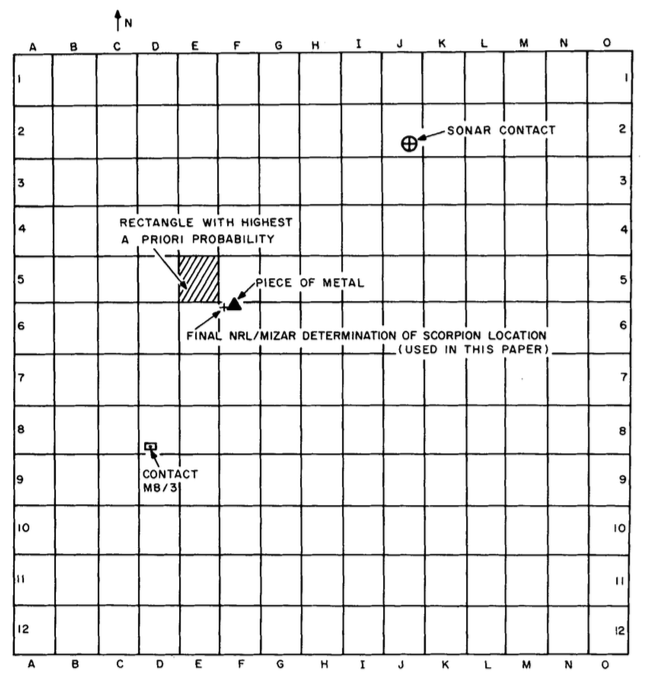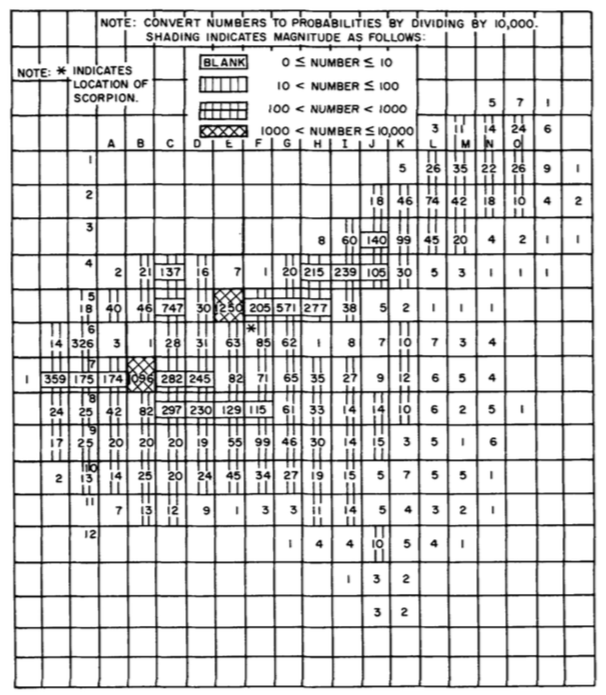theme: target_trajectory
theme: target_trajectory
Scorpion Search
1950

Scorpion search grid
(Richardson and Stone, 1971, p.144)
Overall A Priori distribution for Scorpion search
(Richardson and Stone, 1971, p.145)In May 1968, a few weeks after the Soviet sub sank, the U.S.S. Scorpion, a nuclear-powered attack sub, disappeared with its crew of 99 in the Atlantic Ocean. The Scorpion was cruising west, toward home, somewhere along a 3,000-mile submarine route between Spain and the East Coast of the United States. It was reportedly armed with two nuclear torpedoes. According to a study made in 1989, Scorpion's reactor and torpedos would be among at least eight nuclear reactors and 50 nuclear warheads to have been lost at sea; of these, 43 were on sunken Soviet submarines and eight originated with U.S. military activities. With the Scorpion’s final resting place unknown, the military launched a full-scale search.
(McGrayne, 2011, p.196)The use of Monte Carlo simulation to generate numbers based on Craven's presearch scenarios and weighting represented a big advance in search work. According to Richardson, "The nice thing with Monte Carlo is that you play a game of let's pretend, like this: first of all there are ten scenarios with different probabilities, so let’s first pick a probability. The dice in this case is a random number generator in the computer. You roll the dice and pick a scenario to work with. Then you roll the dice for a certain speed, and you roll the dice again to see what direction it took. The last thing is that it collided with the bottom at an unknown time so you roll dice for the unknown time. So now you have speed, direction, starting point, time. Given them all, I know precisely where it could have) hit the bottom. You have the computer put a point there. Rolling dice, I come up with different factors for each scenario. If I had enough patience, I could do it with pencil and paper. We calculated ten thousand points. So you have ten thousand points on the bottom of the ocean that represent equally likely positions of the sub. Then you draw a grid, count the points in each cell of the grid, saying that 10% of the points fall in this cell, 1% in that cell, and those percentages are what you use for probabilities for the prior for the individual distributions.”
(McGrayne, 2011, p.199)McGrayne, S. (2011) The theory that would not die : how Bayes’ rule cracked the enigma code, hunted down Russian submarines, & emerged triumphant from two centuries of controversy. New Haven Conn: Yale University Press.
Richardson, H. R. and Stone, L. D. (1971) ‘Operations analysis during the underwater search for scorpions’, Naval Research Logistics Quarterly, 18(2), pp. 141–157. Available at: [link]
theme: target_trajectory
theme: target_trajectory